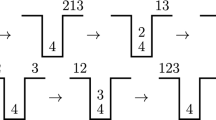Abstract
A pattern is encountered in a word if some infix of the word is the image of the pattern under some non-erasing morphism. A pattern p is unavoidable if, over every finite alphabet, every sufficiently long word encounters p. A theorem by Zimin and independently by Bean, Ehrenfeucht and McNulty states that a pattern over n distinct variables is unavoidable if, and only if, p itself is encountered in the n-th Zimin pattern. Given an alphabet size k, we study the minimal length f(n,k) such that every word of length f(n,k) encounters the n-th Zimin pattern. It is known that f is upper-bounded by a tower of exponentials. Our main result states that f(n,k) is lower-bounded by a tower of n − 3 exponentials, even for k = 2. To the best of our knowledge, this improves upon a previously best-known doubly-exponential lower bound. As a further result, we prove a doubly-exponential upper bound for encountering Zimin patterns in the abelian sense.
Similar content being viewed by others
Notes
Our definition of strict prefix is slightly non-standard as ε is a strict prefix of any non-empty word.
Again, remark that our definition is slightly non-standard as strict prefixes or strict suffixes are in general not strict infixes.
Recall that there are two occurrences of p in [ [i] ]n+ 1.
References
Alon, N., Spencer, J.: The Probabilistic Method. Wiley (2015)
Bėal, M.-P., Carton, O., Prieur, C., Sakarovitch, J.: Squaring transducers: an efficient procedure for deciding functionality and sequentiality. Theor. Comput. Sci. 292(1), 45–63 (2003)
Carayol, A., Göller, S.: On long words avoiding zimin patterns. In: Vollmer, H., Vallėe, B. (eds.) 34th Symposium on Theoretical Aspects of Computer Science, STACS 2017, March 8-11, 2017, Hannover, Germany, volume 66 of LIPIcs, pp. 19:1–19:13. Schloss Dagstuhl - Leibniz-Zentrum fuer Informatik (2017)
Carayol, A., Gȯller, S.: On long words avoiding Zimin patterns. CoRR, arXiv:1902.05540 (2019)
Conlon, D., Fox, J., Sudakov, B.: Tower-type bounds for unavoidable patterns in words (2017)
Cooper, J., Rorabaugh, D.: Bounds on Zimin word avoidance. CoRR, arXiv:1409.3080 (2014)
Cooper, J., Rorabaugh, D.: Asymptotic density of Zimin words. Discret. Math. Theor. Comput. Sci. 18, 3 (2016)
Currie, J.D.: Pattern avoidance: themes and variations. Theor. Comput. Sci. 339(1), 7–18 (2005)
Currie, J.D., Linek, V.: Avoiding patterns in the Abelian sense. Canadian J. Math. 51(4), 696–714 (2001)
Bean, G.F., McNulty, D.R., Ehrenfeucht, A.: Avoidable patterns in strings of symbols. Pac. J. Math. 85, 261–294 (1979)
Flajolet, P., Sedgewick, R.: Analytic Combinatorics. Cambridge University Press, Cambridge (2009)
Jancar, P.: Equivalences of pushdown systems are hard. In: Proceedings of FOSSACS 2014, Volume 8412 of Lecture Notes in Computer Science, pp. 1–28. Springer (2014)
Jugé, V: Abelian ramsey length and asymptotic lower bounds. CoRR, arXiv:1609.06057 (2016)
Reinhardt, K.: The complexity of translating logic to finite automata. In: Automata, Logics, and Infinite Games: A Guide to Current Research, Volume 2500 of Lecture Notes in Computer Science, pp. 231–238. Springer (2001)
Rorabaugh, D.: Toward the combinatorial limit theory of free words. CoRR, arXiv:1509.04372 (2015)
Rytter, W., Shur, A.M.: Searching for Zimin patterns. Theor Comput. Sci. 571, 50–57 (2015)
Sapir, M.V.: Combinatorics on words with applications. Technical report (1995)
Schmitz, S.: Complexity hierarchies beyond elementary. CoRR, arXiv:1312.5686 (2014)
Sėnizergues, G.: The equivalence problem for t-turn DPDA is co-np. In: Proceedings of ICALP, Volume 2719 of Lecture Notes in Computer Science, pp. 478–489. Springer (2003)
Stirling, C.: Deciding DPDA equivalence is primitive recursive. In: Proceedings of ICALP 2002, Volume 2380 of Lecture Notes in Computer Science, pp. 821–832. Springer (2002)
Stockmeyer, L.J.: The Complexity of Decision Problems in Automata and Logic. PhD thesis, Massachusetts Institute of Technology, Cambridge MA (1974)
Tao, J.: Pattern occurrence statistics and applications to the ramsey theory of unavoidable patterns. CoRR, arXiv:1406.0450 (2014)
Thue, A.: Über unendliche Zeichenreihen. Norske Vid. Skrifter I Mat.-Nat. Kl. Christiania 7, 1–22 (1906)
Zimin, A.I.: Blocking sets of terms. Math. USSR Sbornik 47, 50–57 (1984)
Author information
Authors and Affiliations
Corresponding authors
Additional information
Publisher’s Note
Springer Nature remains neutral with regard to jurisdictional claims in published maps and institutional affiliations.
This article is part of the Topical Collection on Special Issue on Theoretical Aspects of Computer Science (STACS 2017)
Rights and permissions
About this article
Cite this article
Carayol, A., Göller, S. On Long Words Avoiding Zimin Patterns. Theory Comput Syst 63, 926–955 (2019). https://doi.org/10.1007/s00224-019-09914-2
Published:
Issue Date:
DOI: https://doi.org/10.1007/s00224-019-09914-2




